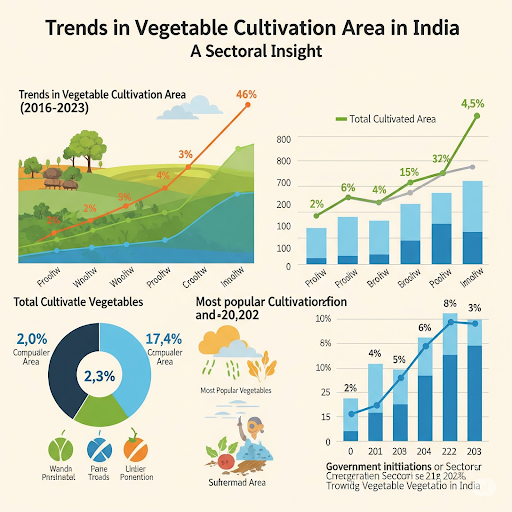Introduction
Vegetable cultivation forms a critical component of Indian agriculture, both in terms of food security and rural livelihoods. India is one of the world's largest producers of vegetables, accounting for about 15% of global production (FAO, 2023). Understanding the trends in the area under vegetable cultivation provides valuable insights into consumer demand, cropping preferences, market dynamics, and policy impact.
The data provided by Mordor Intelligence (2023) illustrates the area under cultivation of various vegetables in India from 2016 to 2023. This period marks significant changes driven by shifting dietary patterns, export opportunities, government schemes, and improved horticultural practices.
Overview of the Data (2016–2023)
The chart shows that the total area under vegetable cultivation in India has steadily increased from 11.6 million hectares in 2016 to 13.7 million hectares in 2023. This nearly 18% rise over seven years signifies a growing interest in horticultural crops, possibly due to better returns compared to cereals and increased consumer demand for fresh produce.
Key Observations:
-
Consistent Growth: A gradual increase each year, with a sharper rise after 2020, possibly linked to changing agricultural strategies post-COVID-19.
-
Major Contributors:
- Potato, Onion, and Tomato consistently occupy the largest portions of cultivated area.
- Other Unclassified Vegetables show a steady increase, indicating diversification in cropping systems.
Crop-Wise Analysis
1. Potato, Onion, and Tomato (POT Crops)
These three crops dominate India's vegetable basket:
- Potato cultivation remained relatively stable but shows slight year-on-year growth, particularly after 2020.
- Onion area increased marginally, reflecting strong domestic and export demand.
- Tomato area witnessed a small but visible rise, suggesting growing demand for processed tomato products and fresh consumption.
2. Other Vegetables
- Eggplant, Okra, Peas, and Cucurbits have maintained consistent cultivation areas, contributing to dietary diversity and regional cropping patterns.
- Cauliflower and Broccoli reflect minimal but steady growth, driven by urban health trends and rising awareness of nutrition.
3. Unclassified and Miscellaneous Vegetables
This category has grown the most proportionally, suggesting increasing farmer interest in niche crops, local vegetables, and exotic varieties for urban markets.
Factors Driving Expansion
Several factors have contributed to the rise in vegetable cultivation:
- Government Policies: Initiatives under the National Horticulture Mission (NHM) and the Rashtriya Krishi Vikas Yojana (RKVY) have supported vegetable growers with inputs, subsidies, and infrastructure.
- Market Demand: Rising population, urbanization, and shifting dietary preferences have spurred demand for fresh vegetables.
- Export Potential: India’s vegetable exports, especially of onions and okra, have seen expansion, incentivizing cultivation.
- Crop Diversification: Farmers are gradually moving from cereal monoculture to high-value crops like vegetables due to better price realization.
Implications for Agri-Policy and Planning
The rising trend highlights the need for:
- Cold chain infrastructure to reduce post-harvest losses.
- Market linkages and digital platforms to connect growers with consumers.
- Research and development in pest-resistant and high-yielding vegetable varieties.
- Irrigation support to sustain cultivation, especially in water-intensive vegetables.
Conclusion
The expansion in vegetable cultivation area in India from 2016 to 2023 reflects an encouraging shift toward high-value agriculture. Potatoes, onions, and tomatoes continue to be the pillars of vegetable farming, while the rise in unclassified vegetable categories underscores the sector's diversification. Policymakers, agri-businesses, and researchers must harness this momentum to ensure sustainable and profitable vegetable production in the years to come.
References
-
FAO (2023). Food and Agriculture Organization Statistics. Retrieved from http://www.fao.org/statistics
-
Mordor Intelligence (2023). Area Under Cultivation of Vegetables, Hectare, India, 2016–2023.
-
Ministry of Agriculture and Farmers Welfare (2022). Horticultural Statistics at a Glance. Government of India.
-
NHM (2021). National Horticulture Mission: Guidelines and Reports.
-
Ramesh Chand et al. (2020). Indian Agriculture Towards 2030: Horticulture Sector Performance and Outlook. NITI Aayog.


%20(2).png)

0 Comments